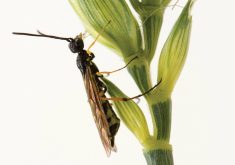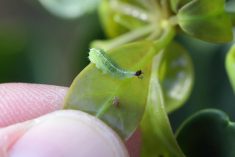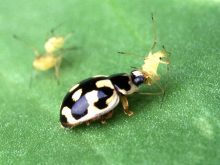A growing number of crop producers are recognizing the role of beneficial insects on their farms. It seems like just about every crop pest has a natural enemy that can keep their populations at bay, while many crops have beneficials that aid their growth and sustainability.
Stuart Lawrence, Dean Hubbard and Ian Steppler are three Prairie crop producers who have integrated beneficial insects into their farm management practices. Here’s how insects help and hinder their crop production efforts.
Dean Hubbard
Claresholm, Alta.
Read Also

Claas brings 1000 Series SP forage harvesters to Canada
In mid-August, Claas unveiled its new line of Jaguar forage harvesters at an event in Visalia, California, deep in the heart of that state’s dairy region.
Wheat stem sawfly is a crop pest that lives in and attacks the stems of crops like wheat, rye, triticale and some varieties of barley. Dean Hubbard, who farms near the southern Alberta town of Claresholm, had fewer problems with the pest once he started using a stripper header for harvesting wheat.
By doing so, Hubbard left a habitat for Bracon cephi — a parasite that acts as a predator for wheat stem sawfly — to survive and thrive.
Adult sawfly females lay eggs in the plant stems. The larvae feed within the stems of plants, affecting both crop yield and grain quality. The larvae also girdle plant stems, causing the stems to break in the wind and the plants to fall over, making the crop difficult to harvest.

But Bracon cephi is on to its game. The native wasp is one of a handful of insect parasites able to move from grass to crops with the sawfly. “It’s a tiny wasp that also lays an egg in the wheat stem. It travels down until it finds the sawfly larvae and then eats it,” says Hubbard.
Scouting for wheat stem sawfly can be time-consuming work. Fortunately, a few years ago, a master’s degree student from the University of Saskatchewan tracked population increases in Bracon cephi in Hubbard’s fields by monitoring sawfly populations.
“At our place the one year, about 50 per cent of the plants actually had sawfly larvae in them and half of them had been parasitized. And I think it was just two years later there was 85 per cent parasitism. That was since I started using the stripper header.”
Stripper headers, of course, leave standing stubble in the field where the parasites take shelter over the winter.
“As long as you don’t mechanically damage the wheat stems, they will overwinter themselves. It’s a natural population, so there are always some around. It’s just a matter of providing them with an environment they can thrive in. We don’t harrow in the spring; we seed right in with the disk drill. We try to minimize any of the damage to that stem.”
Hubbard avoids spraying insecticides as much as he can to provide habitats for the parasite and other beneficial insects.
“I’ll never say never, but we are very hesitant to spray an insecticide. We actually haven’t had to use an insecticide as a spray for a long time although we have used some on seed treatments.”
Stuart Lawrence
Rosetown, Sask.
Stuart Lawrence doesn’t know why he gets aphids in his lentil crops when he sprays foliar fungicide on his crop. What he does know is lady beetles help when he gets those aphid populations.
“Whenever we have a leaf disease in lentils and we have to spray a foliar fungicide, I know, probably, within two weeks, I will have to spray an insecticide for aphids. I’m not exactly sure why that is,” says the producer from Rosetown, which is about 115 kilometres southwest of Saskatoon.
However, he has a theory.
“An agronomist I talk to thinks the fungicide kills a fungus that also kills aphids. That allows an aphid population to spike. What I will do is hire an agronomist with a sweep net to come out and continuously check my lentils and monitor aphid and ladybug populations.”
Why lady beetles? “The aphids are lunch for the ladybugs,” says Lawrence. “I’ve read how many aphids a ladybug eats in a day … it’s a lot. The trick is to get the ladybug population growing as the aphid population is growing.”
Lawrence is the first to admit it’s not a perfect system. He’s rarely had a situation where there have been enough lady beetles to completely keep the aphids in check.
“But in years where I don’t spray a foliar fungicide, I never seem to have an aphid problem and at the same time, I have quite a few ladybugs. Maybe in a normal year the ladybugs keep the aphids down and I don’t have a problem.”
Encouraging lady beetle populations is an extension of Lawrence’s determination to minimize chemical crop protection on his farm.
“I wish I could spray the fungicide and not worry about insects and the ladybugs could take care of things but, unfortunately, it doesn’t seem to always work out that way,” he says.
“I try to do the best I can to not immediately go and grab the jug of whatever to make my problems go away. You kind of hope and wait to see if nature’s going to step up and help a guy out.”
Ian Steppler
Carman, Man.
Like many producers in the early 2000s, Ian Steppler was looking for a profitable enterprise to help him weather the twin storms of BSE and low commodity prices. The mixed producer, who farms near the southern Manitoba town of Carman, found it in beekeeping. Over 22 years, the four-hive operation grew to include 1,500 honey bees and 1,200 colonies and became a symbiotic aid to Steppler’s wheat, oats, barley, canola, sunflower and cattle operation.

It’s a win-win situation for all parties involved — the bees pollinate the crops and improve seed set (the number of seeds on a pollinated flower). They also collect nectar-producing honey, bringing it to the hives that Steppler keeps. In exchange, Steppler retains foliage-rich habitats such as sloughs and bushes that both bees and cattle benefit from.
If there’s a drawback, it’s that it can be difficult to quantify just how much Steppler’s honey bees improve yield in a plant like canola. Canola is open-pollinated, meaning it can be pollinated by any number of natural mechanisms including birds and wind. But going on observation, he’s certain the honey bee activity increases seed set in his canola, ultimately increasing yield.
“There are studies that show (yield in canola) can go up two to five per cent depending on conditions, so there’s benefit directly to the canola fields,” says Steppler, who serves as chairman of the Manitoba Beekeepers’ Association.
Taking an ecosystem management approach has caused him to be more mindful of how he uses crop protection products. He takes pains to ensure bees and other beneficial insects are not affected by his spraying activity.
“We try to manage our pesticide use by spraying in the evening when the bees are away or the bugs are all tucked away out of harm’s way,” he says.
“We also look at different products on the market that are very specific and more targeted. There are products on the market right now that are very specific at killing grasshoppers and worms within crops. It’s a little more expensive, but by using these products it completely relieves the cost of killing off beneficial insects.”
If you’re looking for information on beneficial insects, visit the Field Heroes website at fieldheroes.ca. There you can find tips on how to scout for and identify crop pests as well as learn how beneficials can help you and how you can help them.
















